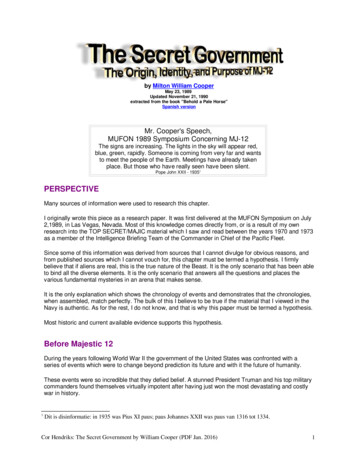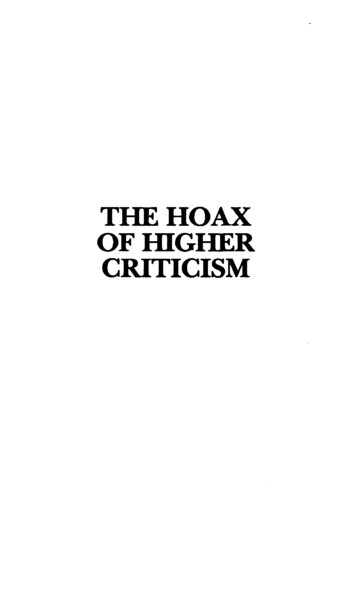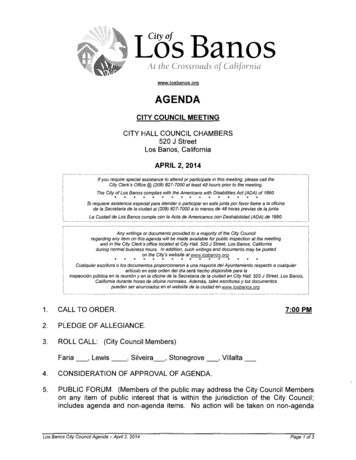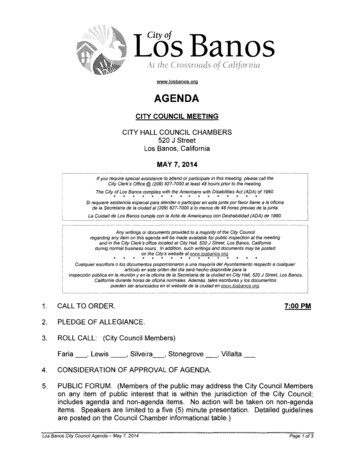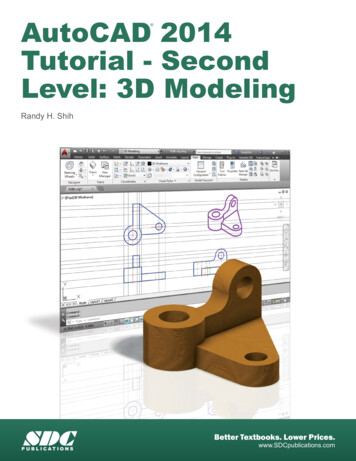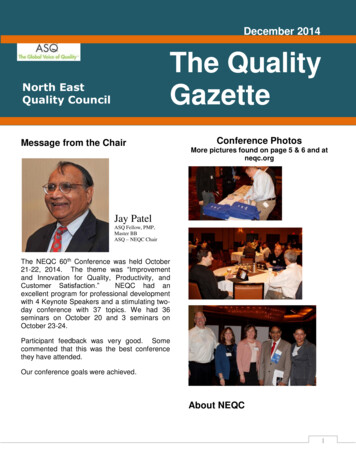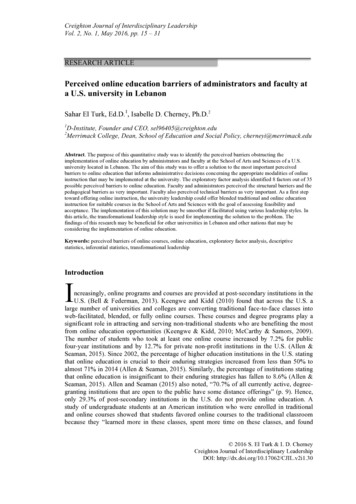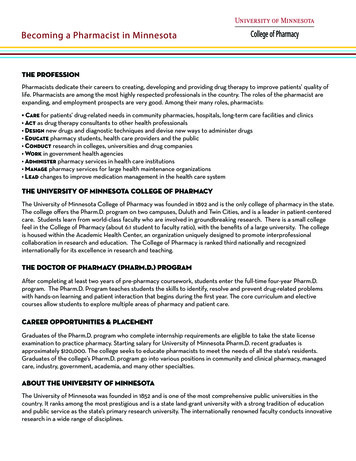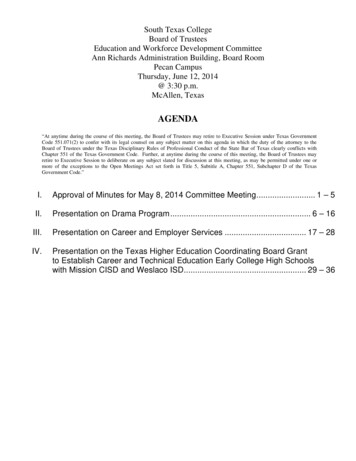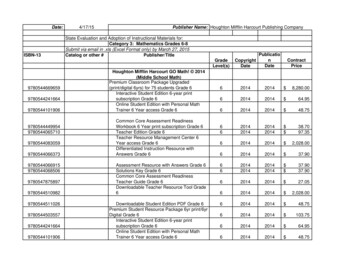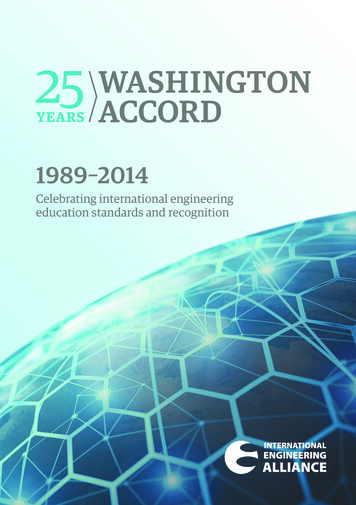
Transcription
1989–2014Celebrating international engineeringeducation standards and recognition
AcknowledgementsThe Chairman and Deputy Chairman of the Washington Accord acknowledge the manycontributors whose competence and commitment contributed to the success of theWashington Accord: The founding signatories The signatories and their delegates over the years for their contributionto meetings, forums, workshops and working groups between meetings Our predecessors as Chairman and Deputy Chairman The various Secretariats: Engineers Canada (1993–1997) Engineers Australia (1997–2001) Abet Inc (2001–2007) The IEA Secretariat provided by IPENZ (2007 – present) The IEA Governing Group since 2007 Some 60 reviewers who have served on visit teams to assess applicationsfor signatory status and periodic review of signatories Our colleagues in the other IEA constituent agreements.
How do we build mutual understandingamong nations about the quality ofengineers who enter the globallyconnected workplace?George Peterson, Washington Accord Secretariat, 2001–2007Neil Caughey
ContentsForeword 4Role of the International Engineering Alliance 6Overview 8A Brief History 10Signatories 12Graduate Attributes 14Perspectives 18Other Accords and Agreements 20IEA Accord Signatories and Agreement Members 2225 Years of the Washington Accord3
ForewordBasil Wakelin, Chair, IEA Governing GroupThe Washington Accord is a constituent of theInternational Engineering Alliance (IEA) whichcomprises educational accords for professionalengineers, engineering technologists andengineering technicians plus two professionalengineering and one engineering technologistcompetency agreements. The IEA is concernedwith engineering education and competenceacross the whole spectrum of engineering.As a founding member and the most senior of theconstituents, the Washington Accord has set thefoundation and standards for graduate attributes and accreditation of programmes anddefines the educational basis for the International Professional Engineers Agreementand APEC Engineers Agreement on competency.The international recognition and portability of both educational qualifications andprofessional competency is becoming increasingly important in this age of globalinterdependence but unbalanced global development, which requires movement ofengineering skills around the world. We cannot afford to waste engineering resourcesor engineering education and it is now widely recognised that the Washington Accordhas made a considerable impact on improvements in engineering education.We are indeed grateful for the substantial but largely voluntary contributions of manyWashington Accord members to the development and maintenance of the standardsand processes to date. However, the future educational challenges are still considerableand will continue to depend on the engineering profession to maintain the momentumand standards.4
Professor Hu Hanrahan, Chair, Washington AccordFor 25 years the Washington Accord has provideda mechanism for mutual recognition of graduatesof accredited programmes among its signatories.This period has seen significant change inthe world of engineering work in engineeringeducation. National accreditation systems andthe Accord itself have evolved to meet changingneeds building on the vision of the original sixsignatories in 1989. The 1990s saw great debateabout engineering education in many countries,culminating in a remarkable consensus tomove from input-focused accreditation criteriato an output-based specification. By 2005 the Washington Accord, then with eightsignatories and soon to expand significantly in Asia, had developed its GraduateAttributes, summarised in this brochure. These provide an exemplar of an outcomesbased specification for programmes that provide the educational base for professionalengineers. The outcomes approach affords education providers freedom in the designof programmes. Best practice in accreditation has been captured in the Accord Rulesand Procedures. The Washington Accord, and the associated Sydney and DublinAccords, are committed to providing the benchmarks for graduates and accreditationpractice as globalisation intensifies.The ongoing development and operation of the Washington Accord rely criticallyon the signatories’ delegates who participate in meetings and working groups aswell as the reviewers who make up the teams that evaluate applicants for signatorystatus and conduct periodic monitoring of signatories. Their valuable contributionis greatly appreciated.25 Years of the Washington Accord5
Role of the InternationalEngineering AllianceThe International Engineering Alliance (IEA) is an umbrella organisation for sixmulti-lateral agreements which establish and enforce amongst their members internationally-benchmarked standards for engineering education and what is termed“entry level” competence to practise engineering. The Alliance, which currently haslead engineering organisations from 23 nations as members (including five G8 and11 G20 nations), is expanding steadily with China being the latest to apply.The IEA’s vision is to:Improve the global quality, productivity and mobility of engineers by being an acceptedindependent authority on best practice in standards, assessment and monitoring ofengineering education and professional competence.The Washington Accord sits under the IEA alongside the Sydney and Dublin Accords.Quality engineers are developed with an accord-recognised degree or equivalent,through experience after graduation to develop both professional and personalmaturity, and by meeting an agreed competence typically measured by evaluationagainst 13 elements.The IEA’s core activities: Consistent improvement of standards and mobility Defining standards of education and professional competence Assessment of education accreditation and evaluation of competence Participation in activities that are driven from the engineering profession.6
The first andsubsequentmeetings werecharacterisedby a visionaryattitude andmutual respect.Dr Finbar Callanan,Former Director General,The Institution of Engineersof IrelandVirandra Babu
OverviewThe development of a professional engineer to the level required for independentpractice or licensure/registration has two stages. The education stage, normallyprovided by an externally accredited programme of four or five years post-secondaryschool, is followed by a period of supervised training while gaining experience inengineering practice. The individual may then have his or her competence assessed,and be eligible for recognition as a competent individual engineering practitioner.Education and Training in the Formation of a Practising EngineerMeet standardof engineeringeducationMeet standardfor professionalcompetencyACCREDITEDPROGRAMMEGraduate Attributes:indicate that programmeobjectives are satisfied8TRAINING ANDEXPERIENCEObserve codeof conductand maintaincompetencePRACTICE
The Washington Accord is a self-governing, autonomous agreement between nationalorganisations (signatories) that provide external accreditation to tertiary educationalprogrammes that qualify their graduates for entry into professional engineeringpractice. The signatories undertake a clearly-defined process of periodic peer reviewto ensure each other’s accredited programmes are substantially equivalent andtheir outcomes are consistent with the published professional engineer graduateattribute exemplar.Signatories agree to grant (or recommend to the relevant national registration body,if different) graduates of each other’s accredited programmes the same recognition,rights and privileges as they grant to graduates of their own accredited programmes.By these provisions, the Accord facilitates mobility of graduates between signatoryjurisdictions and deeper understanding and recognition of their engineering educationand accreditation systems. Amongst the signatories’ educational providers, adherenceto local accreditation requirements that are consistent with the professional engineergraduate attribute exemplar contributes to international benchmarking of programmeoutcomes.There are currently 15 signatories to the Washington Accord that together deliver over7,000 programmes producing graduates that are significantly similar in competencies.This booklet outlines the history and development of the Washington Accord, as theleading international educational agreement for professional engineering qualificationsand as the inspiration for further educational accords and professional competenceagreements that collectively work together as the IEA.The education stage is followedby a period of supervised trainingwhile gaining experience inengineering practice.25 Years of the Washington Accord9
A Brief HistoryIn 1989 the six foundation signatory organisations from Australia, Canada, Ireland,New Zealand, the United Kingdom and United States observed that their individualprocesses, policies, criteria and requirements for granting accreditation to universitylevel programmes were substantially equivalent. They agreed to grant (or recommend to registering bodies, if different) the same rights and privileges to graduatesof programmes accredited by other signatories as they grant to their own accreditedprogrammes.The signatories committed to: continue to share relevant information; allow theirrepresentatives to participate in each other’s accreditation processes and attendrelevant meetings of their organisations; and to make reference to this agreementin publications listing accredited programmes.After rather informal operation in its early years, with bi-annual meetings in oddnumbered years and simple rules and procedures, the growth in interest by otherorganisations indicated the need for more structure and formality. Formal rules andprocedures were developed for a six-year peer-review of signatories and for admissionof new signatories, following a period in provisional status.The Sydney and Dublin Accords for engineering technologists and engineeringtechnicians were initiated in 2001 and 2002, respectively. Together with the threeagreements for engineering practitioners, the IEA was formed in 2007, and the IEASecretariat was created to assist with the administration of the accords and agreements and their development.Washington Accordsigned by sixorganisations198928 September10Development offormal peer reviewprocesses1990sonwardsNewaccords andagreements1997–2002Development ofgraduate attributeexemplars2001onwards
The admission to the Washington Accord of the accreditation organisations in HongKong China and South Africa in the late 1990s and Japan, Singapore, Chinese Taipei,Korea and Malaysia took the number of signatories to 11 by 2009. Since that year,the accrediting organisations in Turkey and Russia have become signatories. Currently there are also five organisations with provisional status. Many of the newand provisional signatories were mentored by established ones as they developedtheir systems.The adoption of graduate outcome specifications in tertiary education was paralleledby the development of the specification of consensus graduate attributes for theaccords. Version 3 was adopted by the accords in 2013 as the exemplar of the educational requirements to be met by signatories.Whilst accord recognition strictly applies only to education programmes offered withina signatory’s territorial boundaries, the need to accommodate developments in crossborder education has required development of rules for out-of-territory accreditationand recognition. The rules agreed to in 2008 also allow for assistance to emergingeconomies that may be too small to operate their own accreditation system. The rulesare currently under review.The Accord recognises that the members of the European Network for Accreditationof Engineering Education (ENAEE) operate similar accreditation processes to similarstandards within Europe, and its authorised members provide the Eur-ACE label toaccredited programmes. Four of the Accord members are also authorised members ofENAEE. There is a formal mechanism between the IEA and ENAEE to maximise mutualunderstanding and potential benefits of the two ment of rules fortrans-national accreditationand Accord recognition2008onwards25 Years of the Washington AccordWashingtonAccord signatoriesreach 152012Relationshipwith ENAEE2013onwards11
SignatoriesThe signatory for each jurisdiction is the recognised organisation for accreditationof professional engineering qualifications. They are listed by jurisdiction, in orderof admission to the Accord, with the current operating name of the accreditingorganisation.AustraliaEngineers AustraliaCanadaEngineers CanadaIrelandEngineers IrelandNew ZealandInstitution of Professional Engineers New ZealandUnited KingdomEngineering Council United KingdomUnited StatesAccreditation Board for Engineering and Technology1995Hong Kong ChinaThe Hong Kong Institution of Engineers1999South AfricaEngineering Council of South Africa2005JapanJapan Accreditation Board for Engineering Education2006SingaporeInstitution of Engineers Singapore2007KoreaAccreditation Board for Engineering1989Education of KoreaChinese TaipeiInstitute of Engineering Education Taiwan2009MalaysiaBoard of Engineers Malaysia2011TurkeyMUDEK (Association for Evaluation andAccreditation of Engineering Programs)2012Association for Engineering Education of RussiaRussiaThere are currently 15 signatories to theWashington Accord that together deliverover 7,000 programmes.12
The Accord requires a body that wishes to become a signatory to first apply forprovisional status. The body must demonstrate it has an accreditation system thatmeets basic requirements. To proceed to signatory status the body must demonstratesubstantial equivalence of its standards and processes in a review by a team drawnfrom the signatories, and be approved by unanimous agreement of the signatories.The following organisations hold provisional status:BangladeshBoard of Accreditation for Engineering and Technical EducationChinaChina Association for Science and TechnologyIndiaNational Board of AccreditationPakistanPakistan Engineering CouncilPhilippinesPhilippine Technological CouncilSri LankaInstitution of Engineers Sri LankaCanadaUnited StatesRussiaUnited KingdomIrelandJapanKoreaTurkeyChinese TaipeiHong KongSingaporeSouth AfricaMalaysiaAustraliaNew Zealand25 Years of the Washington Accord13
Graduate AttributesThe graduate attributes adopted by the Washington Accord signatories are generic tothe education of professional engineers in all engineering disciplines. They categorisewhat graduates should know, the skills they should demonstrate and the attitudes theyshould possess. The graduate attributes have been refined over more than a decadeand in 2013 were adopted by the signatories as the exemplar (or reference point)against which substantial equivalence of their own accreditation requirements are tobe assessed. In addition, the graduate attributes are intended to assist signatories andprovisional members to develop outcomes-based accreditation criteria for use by theirrespective jurisdictions.The key features of the graduate attributes are summarised in the following tables. Adefining characteristic of professional engineering is the ability to work with complexity and uncertainty, since no real engineering project or assignment is exactly the sameas any other (otherwise the solution could simply be purchased or copied). Accordingly,the attributes place as central the notions of complex engineering problems andcomplex problem solving.The Washington Accord Graduate Attribute Profile has 12 elements, supported bya Knowledge Profile, WK1-WK8, and a definition of the Level of Problem Solving,WP1-WP7, both given below:EngineeringknowledgeWA1: Apply knowledge of mathematics, natural science, engineeringfundamentals and an engineering specialisation as specified in WK1 toWK4 respectively to the solution of complex engineering problems.Problem analysisWA2: Identify, formulate, research literature and analyse complexengineering problems reaching substantiated conclusions using firstprinciples of mathematics, natural sciences and engineering sciences(WK1 to WK4).Design/developmentof solutionsWA3: Design solutions for complex engineering problems and designsystems, components or processes that meet specified needs withappropriate consideration for public health, and safety, cultural, societaland environmental considerations (WK5).14
InvestigationWA4: Conduct investigations of complex problems using research-basedknowledge (WK8) and research methods including design of experiments,analysis and interpretation of data, and synthesis of information to providevalid conclusions.Modern tool usageWA5: Create, select and apply appropriate techniques, resources andmodern engineering and IT tools, including prediction and modelling,to complex engineering problems, with an understanding of the limitations (WK6).The engineer andsocietyWA6: Apply reasoning informed by contextual knowledge to assesssocietal, health, safety, legal and cultural issues and the consequentresponsibilities relevant to professional engineering practice andsolutions to complex engineering problems (WK7).Environment andsustainabilityWA7: Understand and evaluate the sustainability and impact ofprofessional engineering work in the solution of complex engineeringproblems in societal and environmental contexts (WK7).EthicsWA8: Apply ethical principles and commit to professional ethicsand responsibilities and norms of engineering practice (WK7).Individualand teamworkWA9: Function effectively as an individual, and as a memberor leader in diverse teams and in multi-disciplinary settings.CommunicationWA10: Communicate effectively on complex engineering activities withthe engineering community and society at large, such as being able tocomprehend and write effective reports and design documentation,make effective presentations and give and receive clear instructions.Projectmanagementand financeWA11: Demonstrate knowledge and understanding of engineering management principles and economic decision-making and apply these to one’sown work as a member and leader in a team, to manage projects and inmulti-disciplinary environments.Life-long learningWA12: Recognise the need for, and have the preparation and ability toengage in, independent and life-long learning in the broadest contextof technological change.25 Years of the Washington Accord15
The Washington Accord Knowledge Profile has eight elements:WK1 systematic, theory-based understanding of the natural sciences applicable to theAdiscipline.WK2 onceptually-based mathematics, numerical analysis, statistics and formal aspectsCof computer and information science to support analysis and modelling applicableto the discipline.WK3 systematic, theory-based formulation of engineering fundamentals required inAthe engineering discipline.WK4 ngineering specialist knowledge that provides theoretical frameworks and bodiesEof knowledge for the accepted practice areas in the engineering discipline; much isat the forefront of the discipline.WK5Knowledge that supports engineering design in a practice area.WK6 nowledge of engineering practice (technology) in the practice areasKin the engineering discipline.WK7 omprehension of the role of engineering in society and identified issues inCengineering practice in the discipline: ethics and the professional responsibility ofan engineer to public safety; and the impacts of engineering activity – economic,social, cultural, environmental and sustainability.WK8 Engagement with selected knowledge in the research literatureof the discipline.Nicki Fleury16
Complex engineering problems have a range of attributes. At least some of thefollowing may be encountered within a professional engineering educationprogramme:Depth of knowledgerequiredWP1: Cannot be resolved without in-depth engineering knowledgeat the level of one or more of WK3, WK4, WK5, WK6 or WK8 whichallows a fundamentals-based, first principles analytical approach.Range of conflictingrequirementsWP2: Involve wide-ranging or conflicting technical, engineeringand other issues.Depth of analysis requiredWP3: Have no obvious solution and require abstract thinkingand originality in analysis to formulate suitable models.Familiarity of issuesWP4: Involve infrequently encountered issues.Extent of applicable codesWP5: Outside problems encompassed by standards and codesof practice for professional engineering.Extent of stakeholderinvolvement and needsWP6: Involve diverse groups of stakeholders with widelyvarying needs.InterdependenceWP 7: High level problems including many component partsor sub-problems.The attributes of complex engineering activities, some of which might reasonably beencountered by a professional engineering undergraduate (eg. during capstone designor a period of industry experience):Range of resourcesEA1: Involve the use of diverse resources (and for this purposeresources include people, money, equipment, materials,information and technologies).Level of interactionsEA2: Require resolution of significant problems arising frominteractions between wide-ranging or conflicting technical,engineering or other issues.InnovationEA3: Involve creative use of engineering principlesand research-based knowledge in novel ways.Consequences to societyand the environmentEA4: Have significant consequences in a range of contexts,characterised by difficulty of prediction and mitigation.FamiliarityEA5: Can extend beyond previous experiences by applyingprinciples-based approaches.25 Years of the Washington Accord17
PerspectivesHow do we build mutual understanding among nations about the quality of engineerswho enter the globally connected workplace? The Washington Accord agreementanswered the question. Begin by building bridges toward mutual recognition of thesubstantial equivalence of engineering education. The fundamental supports for thisbridge are globally accepted attributes expected of successful engineers.The founding signatories of the Washington Accord agreed that graduates of each other’saccredited programmes were expected to possess these attributes and therefore wereprepared to enter engineering practice. The Washington Accord model has become theinternational gold standard for mutual recognition of engineering education.George PetersonWashington Accord Secretariat, 2001–2007I remember my years as chair at a time of international co-operation with like-mindedcolleagues. We worked together to our mutual benefit, making a global contribution tothe competence and recognition of the global engineering profession. The importanceof this and the contribution of engineers are increasingly recognised.There are many examples of crucial team efforts but I believe the devising andsteering through of a paid standing Secretariat was very important. The Secretariatmade all other work more effective and achievable. There were two aspects of theWashington and other Accords and forums in the Alliance that impressed me most:the acknowledgement of each other’s cultures and the joint work to encourage newmembers to participate in the work and leadership needed. Many Asian countries wentswiftly from applicants to active participants and leaders, improving and extending ouractivities. For all these reasons I found this a most stimulating part of my career.Dr Peter GreenwoodWashington Accord Chair, 2002–200718
When Professor Jack Levy convened the first meeting of representatives of the initialsix countries to discuss a possible accord, we hardly foresaw the international success itwould eventually become. I remember very well how the first and subsequent meetingswere characterised by a visionary attitude and mutual respect which greatly expeditedthe early development of the Accord.Another significant and lasting memory for me was chairing the meeting in Dublinwhich welcomed Hong Kong into the Accord as the first new member after the originalsix. It was indeed a genuine pleasure and privilege to work with so many dedicatedcolleagues and good friends during those early formative years.Dr Finbar CallananFormer Director General, The Institution of Engineers of Ireland(Now Engineers Ireland) he Washington Accord modelThas become the international goldstandard for mutual recognition ofengineering education.25 Years of the Washington Accord19
Other Accords and AgreementsThe IEA is a group of self-regulating educational Accords and professional competencerecognition agreements which have a substantially equivalent view of what constitutesan acceptable professional engineering education and professional competence.The Sydney and Dublin AccordsThe Sydney Accord was signed in 2001 to cover equivalence and international recognition for educational programmes for engineering technologists or incorporatedengineers (under the United Kingdom definition). Currently there are nine signatoriesrepresenting Australia, Canada, Ireland, Hong Kong China, Korea, New Zealand, SouthAfrica, the United Kingdom and United States, and one organisation with provisionalstatus (Chinese Taipei). Canada is represented by the Canadian Council of Techniciansand Technologists; all others are signatories to the Washington Accord. Most SydneyAccord qualifications are degrees of three years duration post-secondary school. Thegraduate attribute specification refers to broadly-defined engineering problems.The Dublin Accord was signed in 2002 to cover equivalence and internationalrecognition of engineering technician qualifications. The current eight signatories,for Australia, Canada, Ireland, Korea, New Zealand, South Africa, the United Kingdomand United States, are the same organisations as the signatories to the Sydney Accordand Washington Accord. Most Dublin Accord qualifications are diplomas of two yearsduration post-secondary school. The graduate attribute specification refers to welldefined engineering problems.20
The Engineers Competence AgreementsThe International Professional Engineers Agreement (IPEA) was originally created in1997 as the Engineers Mobility Forum agreement and adopted its new name in 2012.This is a multi-national agreement between engineering organisations in the memberjurisdictions. The agreement creates the framework for the establishment of aninternational standard of competence for professional engineering, and then empowerseach member organisation to establish a section of the International ProfessionalEngineers (IntPE) register.Members have full rights of participation in the agreement; each operates a nationalsection of the IntPE register; registrants on these national sections may receive creditwhen seeking registration or licensure in the jurisdiction of another member.The current 16 members are Australia*, Canada*, Chinese Taipei* (Chinese Institute ofEngineers), Hong Kong China*, India (Institution of Engineers India), Ireland, Japan*(Institution of Professional Engineers Japan), Korea* (Korean Professional EngineersAssociation), Malaysia*, New Zealand*, Singapore*, South Africa, Sri Lanka, the UnitedKingdom and the United States* (National Council of Examiners for Engineeringand Surveying). There are three provisional members from Bangladesh, Pakistanand Russia*. Where the representative member is not indicated, it is the same as theWashington Accord signatory. Representatives marked * are also members of theAPEC Engineer agreement which operates to the same standard of competence asthe IPEA, and has, in addition, members from Indonesia, the Philippines and Thailand.The APEC Engineer agreement was established in 2000 by the member economies ofthe Asia-Pacific Economic Co-operation agreement.The International Engineering Technologist Agreement (IETA) (formerly the EngineeringTechnologist Mobility Forum) was formed by five of the foundation signatories ofthe Sydney Accord to provide equivalent standards and registers for engineeringtechnologists. The current members represent Canada, Hong Kong China, Ireland,New Zealand, South Africa and the United Kingdom. Australia is a provisional member.25 Years of the Washington Accord21
IEA Accord Signatoriesand Agreement MembersAs at June 2013WA Washington AccordSA Sydney AccordDA Dublin AccordIPEA International Professional Engineers AgreementIETA International Engineering Technologist AgreementAPEC APEC Engineer agreement Signatory/Member Provisional StatusAustraliaWAEngineers AustraliaSADAIPEAIETAAPECBangladeshWABangladesh Professional Engineers, Registration Board (BPERB)IPEACanadaEngineers CanadaWAIPEAAPECCanadian Council for Technicians and Technologists (CCTT)SADAIETAChinaWAChina Association for Science and Technology (CAST)Chinese TaipeiInstitute of Engineering Education Taiwan (IEET)Chinese Institute of Engineers (CIE)IPEAWASAAPECHong Kong ChinaHong Kong Institution of Engineers (HKIE)22WASAIPEAIETAAPEC
IndiaNational Board of Accreditation (NBA)WAIPEAInstitution of Engineers IndiaIndonesiaInstitution of EngineersAPECIrelandEngineers IrelandWASADAIPEAIETAJapanWAJapan Accreditation B
agreements for engineering practitioners, the IEA was formed in 2007, and the IEA Secretariat was created to assist with the administration of the accords and agree-ments and their development. Washington Accord signed by six . organisations. 1989. 28 September . Development of formal peer review . processes. 1990s . onwards. New accords and .

